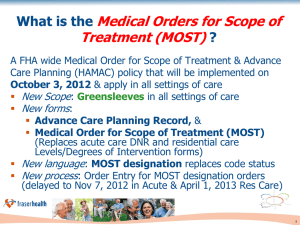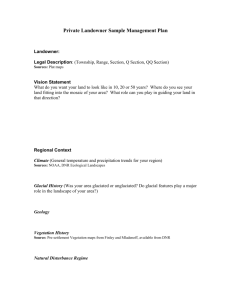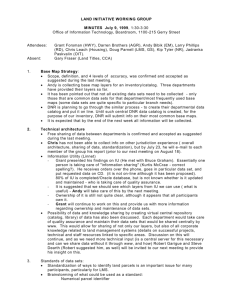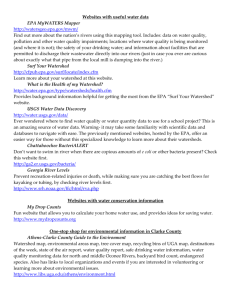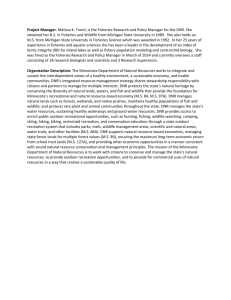Section 319 Summit - Wisconsin Land+Water
advertisement
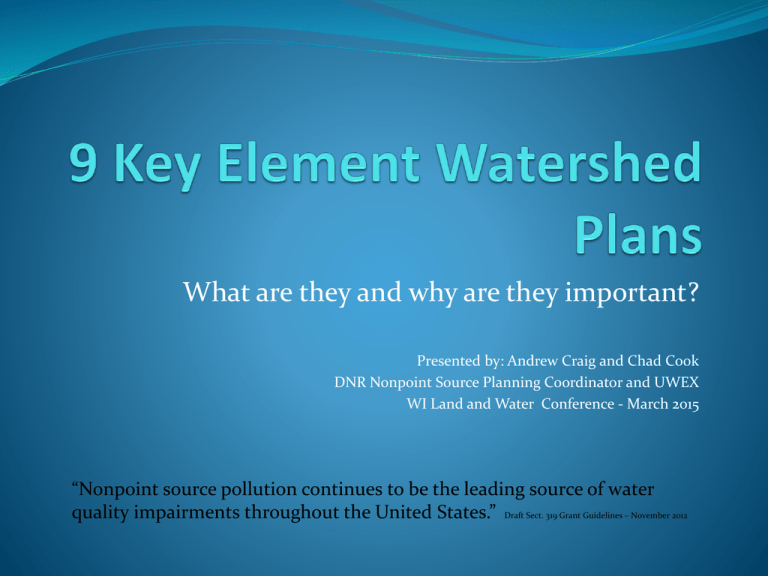
What are they and why are they important? Presented by: Andrew Craig and Chad Cook DNR Nonpoint Source Planning Coordinator and UWEX WI Land and Water Conference - March 2015 “Nonpoint source pollution continues to be the leading source of water quality impairments throughout the United States.” Draft Sect. 319 Grant Guidelines – November 2012 What are 9 Key Element Plans? Watershed based (HUC 12 size – 35 square miles) Restore impaired waters by reducing nonpoint runoff sources (agriculture and urban) Can also protect non-impaired waters Mimic TMDL’s – ID sources and reduce pollutant loads to meet water uses (fishable, swimmable, drinkable) Framework to incorporate existing activities/plans: County LW plans, Farmland Preservation Program NR 151 implementation, Ordinances Grants – state and federal – TRM, NOD, Lakes and Rivers Water Quality and Habitat Monitoring, TMDLs 9 Key Elements Identify the causes and sources that need to be controlled to achieve pollutant load reductions Quantify significant sources and background levels Use Maps and Tables Describe management measures that need to be implemented to achieve load reductions Map priority areas for practices Estimate the load reductions expected from selected management measures SWAT, SNAP+, STEPL, EVAAL, BARNY 9 Key Elements Estimate amounts of technical and financial assistance , costs and authorities relied upon to implement the plan Long Term Operation and Maintenance of BMPs Monitoring and Evaluation Information/education component to encourage participation and plan implementation Schedule for implementing the management measure 5, 10, 15 or 20 years? Include plan milestones 9 Key Elements Interim, measurable milestones to assess if plan is being implemented Set of criteria to determine whether plan objectives are or are not being achieved over time If little progress, how and when will plan be revised? Monitoring component to evaluate the effectiveness of the implementation efforts over time using criteria from above Integrate with schedule and milestones Use WQ and habitat monitoring; WQ modeling Importance of 9KE plans County LW plans ATCP 50 revised in 2014 Revisions to LW plan content and development ATCP 50.12 Revisions DO NOT REQUIRE meeting 9 Key Elements or EPA approval Revisions are CONSISTENT with 9 Key Elements Over time, some LW plans will meet 9 Key Elements in specific watersheds (TMDL’s, etc); not the entire county ATCP 50.12 - Content Element 1 Element 4 Element 2 & 3 Element 1, 3, 6 Element 3 Element 1 & 3 ATCP 50.12 Content Element 4 Element 4 Element 4, 6, 7 Element 7, 8, 9 Element 5 Element 1- 9 ATCP 50.12 - Development Element 1- 9 Element 1- 9 County LW plans Two options to address the 9 Key Elements: Develop a separate 9 Key Element plan Use existing information from LW plan, TMDL, WQ data AND Reference the 9 element plan in LW plan Revise LW plan to reflect the 9 Key Elements For specific watersheds, not county wide EPA 2015 grant requirements DNR Nonpoint activities funded with EPA 319 grant funds should be linked to water quality outcomes Focus on restoration of impaired waters via watershed based plans At least 50% of 319 funds must be used in 319 eligible areas 319 eligible area = has a plan consistent with EPA’s 9 Key Elements - DNR/EPA review Pink = approved TMDLs Cross-hatch = 319 eligible Expire in 2016-2019 Pink and some cross hatch areas will become ineligible in 2015 w/o 9 element plan Green = Impaired Water Green /Red = Recently Approved Yellow =Expire in 2016 White = Expire in 2019 Green = Impaired Waters EPA & DNR Review of 9 Element Plans “EPA regions will annually review a sample of WBPs from each state and provide feedback and recommendations to help ensure the plans lay a good foundation for efforts to restore and/or protect waterbodies.” “EPA will select the plan(s) for review and conduct each review using a protocol that will be communicated with the states in advance of the reviews.” 9KE plans under development In 2014, DNR used Federal 319 funds to help develop 9 Key Element plans across the state Provide ‘example plans’ to help meet the 9 Key Elements 5 projects selected Eau Claire, Marinette, Brown, Outagamie and Marathon Counties Not likely Federal 319 funds can used to develop plans in future 9 Element Plan Timeline December 2014 - 319 project $ awarded January – September 2015 – develop 9 Key Element Plan October – November 2015 - submit draft plan to DNR and EPA for review November - December 2015 - revise plan and get ‘approval’ plan is consistent with 9 Key Elements 9KE TMDL plans under development Lafayette County – 2 TMDL basins Red Cedar TMDL - Barron and Dunn Counties Rock River TMDL – 8 counties Jackson and Mason Creeks – Rock River TMDL – Walworth County Little Lake Wissota TMDL – Chippewa County Wisconsin River Basin?? Milwaukee River Basin?? Upper Fox and Wolf River Basins?? DNR, GLRI grants & 9 Key Elements DNR Grants TRM, NOD, Lakes and River grants are funded with Federal 319 and State $ Multiple funding sources used to increase number of nonpoint projects across the state Projects using 319 Federal funds must have an approved 9 Key Element plan GLRI grants GLRI projects funded with a combination of Federal and local /state funds In 2015, projects using Federal GLRI funds must have an approved 9 Key Element plan EPA and DNR will be reviewing the plans for consistency with 9 Key Elements 319 Funds and Grant Structure $4 million dollars per year Program Funds ≤ 50% ≥ 50% Project Funds Program Funds (est. $2 million) 20 DNR staff used implement Wisconsin NPS Program Management Plan Program administration NPS Monitoring NPS Research TMDL Development All planning-related activities – NPS, TMDL, etc. NPS-related staff time Project Funds (est. $2 million) Project #1 – Eligible DNR Staff (4 FTEs) NPS Coord, Lakes, WQ Biologists Project #2 – DATCP Contract (staff costs) Project #3 – TRM and NOD Grants – $ 1 million Project #4 – Lake and River Protection Grants – $200K Project #5 – Tier I & III Monitoring (USGS/SLOH/LTE costs) Measuring & Tracking Progress National performance measures for NPS Program WQ-9 - Estimate annual load reductions of nitrogen, phosphorus, and sediment achieved by § 319 funded projects WQ-10 - Number of waterbodies primarily NPSimpaired that are partially or fully restored WQ-SP12 - Improve water quality conditions in impaired watersheds using the watershed approach NPS Success Stories: http://water.epa.gov/polwaste/nps/success319/index.cfm Resources to develop 9 Key Element plans DNR 9 Key Element Web Page dnr.wi.gov - keyword: 9 Key Element Your watershed determines the health of your wetlands, lakes and streams fyi.uwex.edu/watershedplanning Why? • Concise, easy to use. • Focused on Wisconsin. • Restored and protected water resources require good comprehensive planning and management. • Certain elements of planning required to meet DNR grant requirements. 29 “Good” planning • Need buy-in and participation from key stakeholders from the start. • Meet guidelines, yes…but also be implementable. • Not a plan to sit on the shelf. • Dynamic…can be modified easily. • Leads to restored and protected water bodies. 30 Getting Started (chapter 1) • Why and how to create a watershed plan. • Geographic scope of your plan. • Gathering stakeholders (contacting, meeting, organizing). • Education and outreach. 31 What You Need to Know and How to Find It (chapter 2) • A “Watershed Profile”. • Water quality standards. • Designated uses. • Water quality criteria. • Watershed assessment. • Watershed protection. 32 Creating Your Plan (chapter 3) • Prioritizing sources of pollutants. • Vision, goals, objectives, action items, cost estimates. • US EPA’s “Nine Elements of a Watershed Plan”. • Civic engagement. 33 Putting Your Plan into Action (chapter 4) • Overseeing implementation. • Keeping the momentum going. • Defining success. • Monitoring progress. • Modifying your plan. 34 Chad Cook Natural Resource Educator chad.cook@uwex.edu 920-232-1990 fyi.uwex.edu/watershedplanning Presentation produced by the UW–Exrtension Environmental Resources Center Photos by Jeffrey J. Strobel and Kris Stepenuck EPA Handbook for 9 Key Element Watershed Plans DNR Watershed Plan Guidance http://dnr.wi.gov/topic/surfacewater/documents/Watershed Planning_Guidance_final_2013.pdf DNR Healthy Watersheds Assessment http://dnr.wi.gov/topic/watersheds/hwa.html/ Other Tools and DNR Contact Info Tools to develop LW plans dnr.wi.gov – keyword: 9 Key EVAAL STEPL Andrew Craig – DNR Nonpoint Source Planning Coordinator Andrew.craig@wisconsin.gov (608)267-7695
